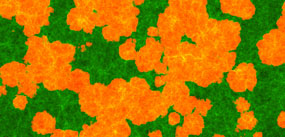Syllabus
Printable syllabus (pdf)
|
Course: |
AST 375 or CS 378: Cosmic Dawn II -- FRI |
|
Semester: |
Fall 2012 |
|
Unique No.: |
47815 (AST 375 -- FRI), 53095 (CS 378 -- FRI) |
|
Hours: |
M & W 2-3 pm |
|
Location: |
RLM 15.201 (computer lab) or RLM 15.216B (classroom) on Mondays and RLM 12.216A (Edmonds Lounge) on Wednesdays |
|
Prerequisites: |
FRI Intro. to Research Methods (including AST 376), Cosmic Dawn I, or by permission |
|
Textbook: |
(Optional) Duncan, T & Tyler, C. Your Cosmic Context: An Introduction to Modern Cosmology (Pearson Addison-Wesley) ISBN: 978-0-13-240010-7 |
|
Website: |
|
|
Instructors: |
Prof. Paul Shapiro (Principal Investigator) |
|
Overview: |
As a student in the Cosmic Dawn research stream, you will get to analyze and visualize new cosmological simulations. These simulations will utilize the computational resources of the Texas Advanced Computing Center, and will be among the most advanced in the world. We will provide you with the necessary background to participate in original scientific research in Cosmology and Astrophysics. This includes (but is not limited to) elements of computer programming, an introduction to supercomputing, physics, astronomy, and mathematical techniques. You will interact with experienced researchers in a team effort to break new ground in this exciting field. |
|
Exams: |
None. |
|
Homework: |
Conduct your ongoing research assignments. |
|
Presentations: |
At the end of the semester you will give an oral presentation to the class on the research conducted over the course of the semester. |
|
Grading: |
A letter grade (without plus/minus system) will be assigned based on the effort and progress you've made in your research project(s). |
|
Notebook: |
Keeping a record of the steps you take to find a result is a critical part of being a good scientist. As such, you are required to maintain a clear and legible lab notebook. As a guideline for keeping a good lab notebook, someone should be able to reproduce your result independently simply by following your notebook, without additional input from you. |
|
Academic |
We have a zero tolerance policy regarding cheating and plagiarism. All students involved in either of these acts will receive zero credit for the work in question and may be subject to further disciplinary action by the University of Texas. |
|
Absences: |
If you must miss class for any reason (i.e. illness, family emergency, etc...), please notify Dr. D'Aloisio ahead of time. You are responsible for the missed material and completing your work within the allowed time frame. In the event of an absence, please feel free to come to office hours for assistance. According to UT Austin policy, you must notify us of your pending absence at least fourteen days prior to the date of observance of a religious holy day. If you must miss a class, an examination, a work assignment, or a project in order to observe a religious holy day, you will be given an opportunity to complete the missed work within a reasonable time after the absence. |
|
Disabilities: |
Students will disabilities can request necessary accommodations from the Division of Diversity and Community Engagement, Services for Students with Disabilities (512-471-6259 or www.utexas.edu/diversity/ddce/ssd/) |
Cosmic Dawn: How the first galaxies formed, ended the dark ages, and reionized the Universe
What are the differences between galaxies born and raised in regions of space that were either crowded or sparse, and how did these differences affect the end of the cosmic dark ages?
Prof. Shapiro's group studies the first billion years of cosmic time when the first galaxies and stars were born, the last window of cosmic time accessible to direct observation. To test current theory, they use supercomputers to simulate the formation of galaxies and largescale structure in the expanding universe. When these galaxies formed stars, starlight escaped into the surrounding gas, heating and ionizing it. This "feedback" impacted future galaxy and star formation and left observable imprints on the universe which astronomers are just now beginning to detect. Students will help make new discoveries with the most advanced simulations in the world, performed at the Texas Advanced Computing Center at UT.
In Spring 2012, we studied the results of a cosmological N-body simulation of galaxy and large-scale structure formation in the LCDM model of the Universe, during the first billion years of cosmic time. We focused on the galactic halos that formed and analyzed the internal properties of individual halos and the correlations between different properties. Our results were presented in a class poster paper. Our Summer Fellows helped lay the groundwork for the next step in which we will study the environmental dependences of these halo properties, this semester.
Goals for this semester:
(1) Finish the work begun last Spring and Summer and turn it into a journal article for submission by last week of classes. This is a team effort, in which individuals will be responsible for different parts, but all helping each other to achieve the common goal.
(2) Learn new tools, principles, and techniques, such as FORTRAN 90, Amiga Halo Finder software, parallel-computing, Texas Advanced Computing Center visualization, and LaTex.
(3) Read and assimilate the current astrophysics literature on our subject.

Reionization Simulation
Principal Investigator
RLM 16.204 · (512) 471-9422 · email
Office Hours
After class, or by appt
Research Educator
Anson D'Aloisio